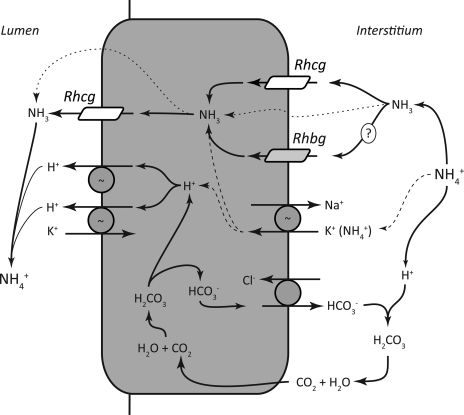Fig. 12.
Detailed model of collecting duct ammonia secretion. We propose the following model of collecting duct ammonia secretion. Interstitial NH4+ is in equilibrium with NH3 and H+. NH3 is transported across the basolateral membrane, predominantly by Rhcg, but also by lipid diffusion (dotted line) and possibly by Rhbg. In the IMCD, basolateral Na+-K+-ATPase transports NH4+ (dashed line). Intracellular NH3 is secreted across the apical membrane by apical Rhcg. There is also likely to be a component of diffusive apical NH3 transport (dotted line). H+-ATPase and H+-K+-ATPase secrete H+, which combines with luminal NH3 to form NH4+, which is “trapped” in the lumen. Apical H+-K+-ATPase may also contribute to NH4+ secretion (not shown) (21). Intracellular H+ is generated by carbonic anhydrase II-accelerated CO2 hydration, forming carbonic acid, which dissociates to H+ and HCO3−. Basolateral Cl−/HCO3− exchange transports the HCO3− across the basolateral membrane, where it combines with H+ released from NH4+, forming carbonic acid, which dissociates to CO2 and water. This CO2 can recycle into the cell, supplying the CO2 used for cytosolic H+ production. The net result is NH4+ transport from the interstitium into the luminal fluid.

